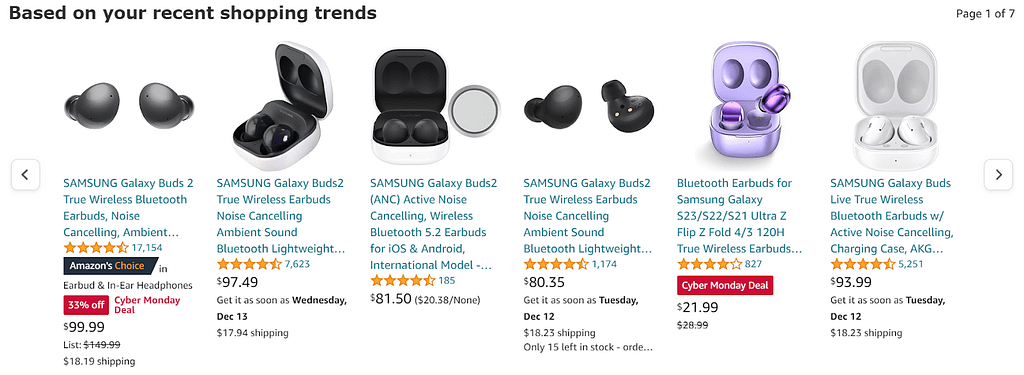In this post, we are going to share hand-picked eCommerce industry trends, emerging and already working in the digital market, as well as tools for adopting them to keep your brand and products visible to your customers in 2024.
AI usage
The use of artificial intelligence (AI) in eCommerce is a significant trend in eCommerce that is expected to continue to grow in the coming years. AI is being utilized in various aspects of modern digital commerce to improve customer experiences, optimize operations, and drive sales. Below, we’ll explore the key applications of AI in digital retail.
AI-driven personalized recommendations
Amazon’s recommendation engine is a prominent example of AI-driven personalized recommendations. By analyzing a customer’s browsing and purchasing history, as well as the behavior of similar customers, Amazon’s recommendation system suggests products that are likely to be of interest to individual shoppers, leading to increased sales and improved customer engagement.

Some of the widespread AI and ML libraries for implementing recommendation systems are TensorFlow, PyTorch, Scikit-learn, and Apache Mahout. Brands like Zara, FarFetch, and ASOS already use them to recommend products.
AI-powered chatbots and customer service
Many eCommerce platforms, such as Shopify, use AI-powered chatbots to provide instant customer support. These chatbots can handle common customer queries, provide order status updates, and offer product recommendations, thereby enhancing the overall customer service experience.
According to BusinessInsider, the chatbots market will grow from $ 2.6 billion in 2019 to $ 9.4 billion by 2024. The popularity of this channel is due to its advantages in terms of UX.
Chatbots suit online brands to resolve the following tasks:
- Collect and update customer databases;
- Keep an additional channel of communication with the consumer handy;
- Serve as an alternative to call center operators for simple actions (for example, checking the in-stock availability, finding a model similar in price, asking about delivery options).
Let’s see some prominent examples of AI-powered chatbots:
- Sephora: Sephora’s chatbot on Facebook Messenger uses AI to provide makeup recommendations based on a user’s skin type, preferred brands, and other factors.
- eBay: eBay’s chatbot on Facebook Messenger uses AI to help find products based on keywords, categories, and other search criteria.
- H&M: H&M’s chatbot on the Kik messaging app uses AI to suggest outfits based on a user’s style preferences and recent purchases. The chatbot also provides links to purchase the suggested items directly from H&M’s website.

Read more: Implementing Conversational Strategy: Does eCommerce Need Chats?
You can use this eCom trend and embed chatbot in your own eCommerce application to optimize your customer journey map and increase conversions. As part of the BMW X6 advertising campaign, Carat and iProspect launched a Twitter chatbot for the first time. It ensured a high audience engagement rate – 1,78%.
Read more: 25 Best AI Marketing Tools In 2024
Predictive analytics
eCommerce platforms like eBay use AI algorithms to analyze customer data and predict purchasing behavior. By identifying patterns and trends in customer interactions, these platforms can optimize pricing, promotions, and inventory management to better meet customer demand and drive sales.
Find more: 5 Digital Marketing Approaches You Should Know About in 2023
Visual search and image recognition
Pinterest’s visual search feature is an example of AI-powered image recognition in eCommerce. Users can take a photo of an item or upload an image, and Pinterest’s AI technology identifies similar products, allowing users to discover and purchase items they find visually appealing.

One popular visual search tool that can be integrated into an eCommerce website is Syte. Syte offers a visual search solution that allows customers to upload an image or take a photo of a product they like, and then find similar products available for purchase on the website.
Another option is ViSenze, which provides visual search and image recognition technology for digital retail websites. Their solution allows customers to search for products using images and find visually similar items in the online store.
Implementing a visual search tool into an eCommerce website typically involves using APIs and integrating the tool with the website’s search functionality. This may require coding and development work to ensure a seamless user experience. Make sure you entrust this development to an IT professional!
Fraud detection and security
PayPal and other online payment processors use AI to detect and prevent fraudulent transactions. AI algorithms analyze transaction data in real time to identify patterns of suspicious activity, helping to protect both merchants and customers from fraudulent behavior.
Find more: Simplifying eCommerce Credit Card Processing: A Comprehensive Guide
Supply chain optimization
Alibaba uses AI to optimize its supply chain operations. By analyzing vast amounts of data, including inventory levels, demand forecasts, and logistical information, Alibaba’s AI systems help streamline the supply chain, reduce costs, and improve overall operational efficiency.
Read more: Best AI Services For Your eCommerce Business
Dynamic personalization
Creating a personalized shopping experience is one of the most promising trends for retailers.
Dynamic personalization on the site allows you to create unique and relevant content for users, select personalized offers, and guide the consumer along the most convenient path to purchase.
Now, it is impossible to imagine a successful online store, which would not have involved dynamic personalization.
For example, a rising online retail trend supposes considering the shopping behaviour to adjust the offer. If you are a clothing retailer and a customer visited your site and searched for a red dress – took a look at different styles, spent some time on dresses, but eventually clicked off – you could then use the data you’ve gathered to enhance their further shopping experience.
PWA applications
Despite the rapid growth of mobile traffic around the world, the mobile version of the site is significantly inferior in convenience to both the desktop and the mobile application. In order to offer an optimal user experience on mobile devices, there is a technology in eCommerce developments called Progressive Web Application (PWA). It visually and functionally transforms the site into an application. This is a booming eCommerce mobile trend. A site that functions as a mobile application is built into the browser. The main goal of a PWA is to adapt and speed up the mobile version of the site, as well as enrich it with features available only for applications.

Interface of PWA solution by Simtech Development
Read more: How to Optimize an eCommerce Website for Mobiles: Looking for an Optimal Solution
Voice shopping
Voice search is one of the latest eCommerce trends, that allows you to communicate much faster with the consumer and lead them to the desired results. According to recent eCommerce statistics from Statista, voice-assisted purchases grew by 400% in 2023.
Voice shopping is a unique type of work with the target audience. It can reduce the load on call centers, facilitate the collection and updating of personal data, increase the average check by reminding them about related products, and increase user loyalty and engagement. For buyers, this is an opportunity to cover immediate search needs and save time on the relatively independent search on the Internet.
Augmented reality
Augmented reality (AR) brings an absolutely new impetus to online shopping trends. It helps visualize products and overcome the discomfort of choosing them. Google states that 66% of users would like to use AR to shop online.
For retailers and brands, augmented reality is a rather complicated and expensive development. It does not pay off in the short term. In the long run, a brand wins that will create the unique and user-friendly shopping experience. The unique user experience differentiates your eCommerce brand from competitors.
One of the pioneers in the use of AR is IKEA. Its Place application helps to see how furniture from the catalog looks in the interior.

IKEA AR-enhanced App
Virtual Reality
Virtual Reality (VR) is indeed an emerging trend in the eCommerce industry. It has the potential to revolutionize the way consumers shop online by providing immersive and interactive experiences. While VR has the potential to transform the eCommerce landscape, it’s important to note that widespread adoption and seamless integration of VR technology into eCommerce platforms are still evolving. As the technology continues to advance and become more accessible, we can expect to see further innovations and applications of VR in the eCommerce sector.

Example of a virtual reality try-on feature for a product in your online store
– Enhanced Product Visualization: VR allows customers to view products in a 3D environment, providing a more realistic and detailed representation of items.
– Virtual Try-On: In the fashion and beauty industries, VR can enable customers to virtually try on clothing, accessories, and makeup, providing a more engaging and personalized shopping experience.
– Virtual Shopping Environments: Retailers can create virtual stores or showrooms that customers can explore using VR technology. This allows for a more immersive and interactive shopping experience, similar to browsing a physical store.
– Interactive Product Demonstrations: VR can be used to provide interactive product demonstrations, allowing customers to explore and interact with products in a virtual space.
– Virtual Events and Experiences: eCommerce businesses can use VR to host virtual events, product launches, or interactive brand experiences, allowing customers to participate from anywhere in the world.
Visual commerce
Visual commerce is all about using imagery for product pages. It can also be used for the entire store to entice users to engage and convert.
Big eCommerce industry players such as Bose and others are already applying visual commerce to influence visitors into purchasing. They have visually appealing images on their homepages accompanied by shortcuts to buy a product directly.

Bose product pictures
– Replace your default product picture format from JPG to JPEG2000 or WebP to increase quality and speed up loading time.
– Create 360-degree images or videos for your bestsellers.
– Invest in a visual search tool or a filter by images to allow customers to search for products using images.
– Repurpose user-generated content on your product pages to generate interest.
Create visual shopping ads on Pinterest to drive traffic to your website and increase sales.

An example of a 3D rotating picture for online stores
Social commerce
Social media platforms are becoming increasingly important for eCommerce businesses, with the ability to sell products directly on platforms like Facebook and Instagram. This can include features such as social shopping, peer recommendations, user reviews, and social media advertising. Tools and services like ZenBusiness helps entrepreneurs set up and manage their online presence efficiently, ensuring they’re well-positioned to take advantage of these social commerce opportunities.
– Facebook Marketplace: Facebook Marketplace allows users to buy and sell items within their local community, with the added benefit of being able to see the seller’s profile and mutual friends.
– Pinterest Buyable Pins: Pinterest allows users to purchase products directly from pins on the platform, making it easy for users to shop for products they discover.
– Instagram Shopping: Instagram allows businesses to tag products in their posts, making it easy for users to shop directly from the app.

Audio advertising
We know it’s been around for the last 50 years in the form of radio ads. And while the radio is slowly dying, podcast streaming is definitely on the rise big time.
Streaming services, especially podcasts, have been proven to establish a much more intimate and authentic connection with the audience compared to just about any kind of media.
Podcasts are so popular because they can stay with people all day long, reaching them in moments where visual media can’t, like, when you are running, driving, working out.
Advertising through podcasts can be an amazing way to reach people based on their interests. And if you can get the host who they already trust to talk about your business, the trust they have on your host is going to be transferred onto you.
Streaming service Spotify has recently launched a self-service, advertising platform called Spotify Ads Studio, which makes it really easy for entrepreneurs like you to create Spotify audio ad campaigns yourself.

Voice track: more intimate and authentic way to connect with your audience.
It is expected that audio content and voice-enabled devices are going to become more unique and personalized, and we also expect podcasts to continue to grow even more mainstream.
CS-Cart has all the necessary default functionality for you to create and manage your own blog. However, if you do decide on producing podcasts and attaching them to your blog posts, you can order our customization service. Our team will develop a blog extension for audio play in a format most suitable to your business needs and customer preferences.
Interactive content
Your prospects can do much more than just consume your static content. They can interact with it, whether it’s taking a poll, answering a quiz, or participating in a challenge of some kind.
This can personalize their experience and prompt them to respond and react while educating and entertaining them on your topic. This gives your business more engagement, which means more views, and that leads to more brand awareness, which eventually translates into more customers.
INSTAGRAM STORY ADS, for example, have a ton of opportunities in eCommerce for being interactive, like pulling stickers and sliders that let people express how they are feeling about something. Add interaction to your ad and let people express what they feel.

Another place where you can add interactivity is your EMAIL LISTS BUILDING. In fact, you need to put a priority on building email lists. It is still number one of the best way to build your business, even in 2020. Changing the regular format of your newsletter and adding a quiz or a multi-day challenge to it will take customer engagement up to a whole new level. People are generally enthusiastic about challenge campaigns because they promise to take them from where they are today to a whole new and improved version of themselves over the course of between five and ten days.

Tommy’s Superfoods: Interactive email campaign
Subscription services
Subscription-based eCommerce models are becoming a new B2B eCommerce trend, with consumers signing up for regular deliveries of products like food, beauty products, and clothing. Subscription technology for eCommerce websites allows businesses to offer products or services on a recurring basis, providing a steady stream of revenue and building customer loyalty. This technology typically includes features such as subscription management, automated billing, customer retention tools, and analytics to track subscription performance.
Sustainability
Consumers are increasingly concerned about the environmental impact of their purchases, and eCommerce businesses can differentiate themselves by offering sustainable and eco-friendly products. Sustainability in eCommerce means practices and strategies that online retailers adapt to reduce their environmental impact and promote sustainable development.
– Second hand stores: provide a sustainable option for purchasing clothing and other items, as they reduce the demand for new production and help to minimize waste.
– ROPO, Research Online, Purchase Offline: allows consumers to research products in web stores for more informed and intentional shopping choices.
– Green packaging: Many eCommerce companies are switching to eco-friendly packaging materials such as recycled cardboard, biodegradable plastics, and compostable materials
– Carbon-neutral delivery: Some eCommerce companies are offsetting the carbon emissions associated with their delivery services by investing in renewable energy projects or reforestation programs.
– Sustainable sourcing: eCommerce companies are increasingly sourcing their products from sustainable and ethical suppliers who use eco-friendly materials and production methods.
– Energy-efficient operations: eCommerce companies are adopting energy-efficient practices in their operations, such as using LED lighting, optimizing their data centers, and using renewable energy sources.
– Recycling programs: Some eCommerce companies are implementing recycling programs for their products and packaging, encouraging customers to return used items for proper disposal or recycling.

Nespresso Sustainability Initiatives
Read more: How to Reduce Your Carbon Footprint with eCommerce Sites: Online Stores and Marketplaces
Same-day delivery
Same-day delivery is a current trend in eCommerce With the rise of eCommerce, the new online shopping trend is that consumers are increasingly expecting faster delivery options, and same-day delivery is seen as a way to meet these expectations and provide a competitive advantage.
Several major retailers and eCommerce platforms have already started offering same-day delivery options, and smaller businesses are also exploring ways to implement this service. Brands like Instacart, Amazon Prime, Best Buy, Walmart, and Postmates offer same-day delivery for groceries and household items from local stores.
Read more: Online Grocery Stores: How to Customize to Include the Best Practices?
Community Marketing
In recent years, there has been a growing trend in eCommerce towards creating a sense of community among customers. This involves building relationships with customers, engaging them in conversations, and creating a sense of belonging. This approach helps in building brand loyalty, increasing customer retention, and driving word-of-mouth marketing.

Our client – highflow.nl
Read more: 10 Tips to Build a Strong Community Around Your eCommerce Brand
Multiple payment options
The eCommerce landscape is witnessing a proliferation of payment options beyond traditional credit cards. This includes the integration of cryptocurrencies, Buy Now Pay Later (BNPL) services, and other alternative payment methods. This trend is driven by the need to cater to diverse customer preferences and to provide a seamless checkout experience. Moreover, the availability of these payment methods in B2C eCommerce is expected to penetrate into B2B transactions, and new eCommerce payment systems are likely to emerge to accommodate this shift.
Increased data privacy
With the growing concerns around data privacy and the increasing demand for transparency, there is a trend towards the refusal of data collection by traditional analytics systems. Consumers are becoming more conscious about their online privacy and are seeking alternatives to mainstream platforms. This has led to the rise of privacy-focused search engines like DuckDuckGo, privacy-centric web browsers such as Brave, and analytics tools like Matomo, which offer more control over data collection. As a result, there is an increasing market share for these alternative systems, and the development of data privacy, is likely to continue to shape the future of eCommerce next years.

For Craftland, we integrated Cookibot to expand customer choices while accepting the data collection policy
Read more: 5 Digital Marketing Approaches You Should Know About In 2023
Development of Return Management Authorization
Return management authorization (RMA) is another area of focus in eCommerce, as businesses seek to streamline the process of handling product returns. This includes implementing efficient return policies, improving the customer experience during the return process, and leveraging technology to automate and optimize return logistics. With the rise of eCommerce, there is a growing need to address return management effectively, as it directly impacts customer satisfaction and operational efficiency.
Wrap up
Stay original, creative, and above all else, authentic in 2024 if you want your brand to be seen as up-to-date and fresh. Empower your efforts with AI tools and integrate more technologies into your website to focus on business and keep on eCommerce innovations.

